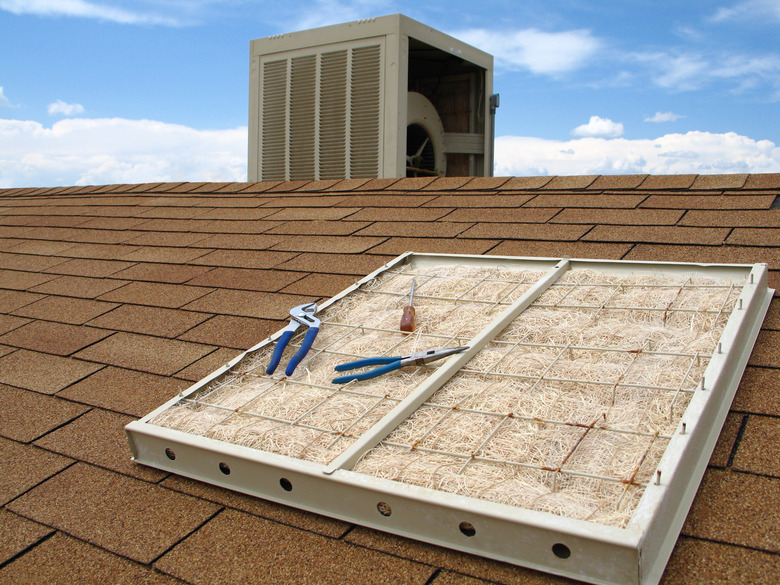Installing A Rooftop Swamp Cooler
In arid climates, swamp coolers are an energy-efficient way of adding moisture to a home while cooling it down. Installing these "evaporative coolers" is typically beyond the average DIYer's skillset, but understanding the installation requirements and procedures can be helpful when hiring a pro.
The Nitty-Gritty on Swamp Coolers
The Nitty-Gritty on Swamp Coolers
Swamp coolers will lower your home's temperature by 15 to 40 degrees Fahrenheit, but the system won't work if your place doesn't have enough windows for air circulation. Unlike air conditioners, swamp coolers provide a constant stream of fresh air, for which open windows are essential.
According to the U.S. Department of Energy, an effective system should do 20 to 40 complete air changes in your space per hour. To make that happen, the swamp cooler's engine will have to be rated to your home size, which affects how large the unit needs to be and, of course, how complicated the installation might be.
The Best Location for Swamp Coolers
The Best Location for Swamp Coolers
The most efficient place to install a swamp cooler is on the roof, and it tends to be the cheapest installation option because it's easier to tie it into existing duct systems. DIYers with smaller homes can install a window-based system. However, professionals tend to favor a ground-mounted swamp cooler to nix the odds of roof leaks and give homeowners safer, easier access for maintenance since these systems do need regular-but-simple maintenance.
The shorter the distance to the "four-way diffuser" used by the system, the cooler the air will be when it enters your space, making proximity to central hallways a smart place to start. This is why roofs are such a popular, and effective, placement for these units.
Wherever it goes, the swamp cooler needs a water supply, which is typically achieved via PVC piping connected to your home's plumbing. The cooler needs to be dead level for smooth running, so this usually means elevating it with legs on the roof.
What You Won’t Need
What You Won't Need
These systems connect to 110-volt outlets. There's no need for refrigeration lines or air return vents. You can connect swamp coolers to existing duct systems, but they work well for smaller or ductless older homes since they use windows and natural air flow for circulation.
Ductwork and Roof-Mounted Coolers
Ductwork and Roof-Mounted Coolers
The rooftop location is ideally close to a central hallway where a four-way diffuser will be most efficient at circulating the air, especially for older homes without air ducts. Be wary if anyone suggests multiple duct outlets rather than the four-way diffuser, as this often dramatically reduces the effectiveness of these systems. Instead, you want a four-way diffuser placed where it has the most opportunity for airflow from the greatest number of windows.
The cooler requires ducting to enter the home through the roof, which generally involves 18 x 18-inch or 20 x 20-inch ductwork. The duct usually comes through an unobstructed part of the roof — so, between the trusses because cutting any trusses in this project would threaten your home's structural integrity. This point of penetration also requires wood framing to secure the entry duct.
Ideally, the duct feeds straight into your ducts or a hallway below. Offset systems or flexible insulated ductwork can be required for reaching the diffuser, if installing right above is impossible, but this reduces efficiency somewhat. Duct insulation may help reduce noise levels as these systems are always a bit noisy.
Connecting the Swamp Cooler
Connecting the Swamp Cooler
Beyond the ductwork access, the cooler needs to be wired into your electrical supply and plumbed to as well. This means a roof jack is needed, plus a plumbing connection into the cold-water source and an electrical line that runs down to a switch.
Ultimately, the process a professional installer will take is:
- Deciding on and preparing the installation site.
- Installing unit duct through the roof and, if applicable,
connecting to the interior duct system. - Assembling the unit, ensuring it's level and mounting it in
place. - Hooking up the water supply and wiring the unit into the
existing electrical system.
And, of course, a professional should tidy the site up and leave your unit looking sparkling by the time they're through. Afterward, you can enjoy your energy-savvy system that will use about 75 percent less energy than an air conditioner, according to the U.S. Department of Energy.
